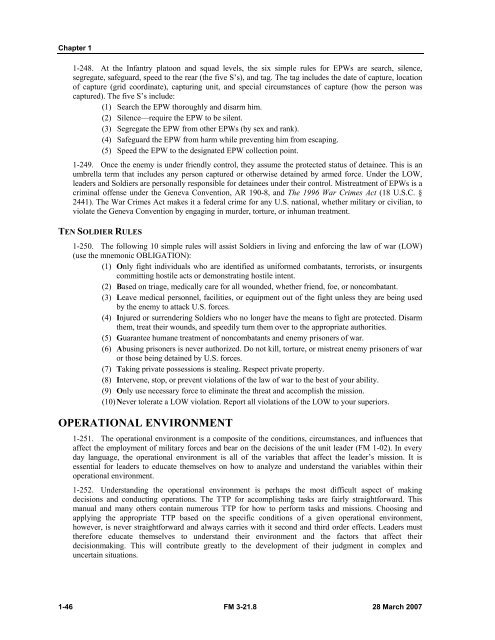Infantry Rifle Platoon and Squad - Sakai
Infantry Rifle Platoon and Squad - Sakai
Infantry Rifle Platoon and Squad - Sakai
You also want an ePaper? Increase the reach of your titles
YUMPU automatically turns print PDFs into web optimized ePapers that Google loves.
Chapter 1<br />
1-248. At the <strong>Infantry</strong> platoon <strong>and</strong> squad levels, the six simple rules for EPWs are search, silence,<br />
segregate, safeguard, speed to the rear (the five S’s), <strong>and</strong> tag. The tag includes the date of capture, location<br />
of capture (grid coordinate), capturing unit, <strong>and</strong> special circumstances of capture (how the person was<br />
captured). The five S’s include:<br />
(1) Search the EPW thoroughly <strong>and</strong> disarm him.<br />
(2) Silence—require the EPW to be silent.<br />
(3) Segregate the EPW from other EPWs (by sex <strong>and</strong> rank).<br />
(4) Safeguard the EPW from harm while preventing him from escaping.<br />
(5) Speed the EPW to the designated EPW collection point.<br />
1-249. Once the enemy is under friendly control, they assume the protected status of detainee. This is an<br />
umbrella term that includes any person captured or otherwise detained by armed force. Under the LOW,<br />
leaders <strong>and</strong> Soldiers are personally responsible for detainees under their control. Mistreatment of EPWs is a<br />
criminal offense under the Geneva Convention, AR 190-8, <strong>and</strong> The 1996 War Crimes Act (18 U.S.C. §<br />
2441). The War Crimes Act makes it a federal crime for any U.S. national, whether military or civilian, to<br />
violate the Geneva Convention by engaging in murder, torture, or inhuman treatment.<br />
TEN SOLDIER RULES<br />
1-250. The following 10 simple rules will assist Soldiers in living <strong>and</strong> enforcing the law of war (LOW)<br />
(use the mnemonic OBLIGATION):<br />
(1) Only fight individuals who are identified as uniformed combatants, terrorists, or insurgents<br />
committing hostile acts or demonstrating hostile intent.<br />
(2) Based on triage, medically care for all wounded, whether friend, foe, or noncombatant.<br />
(3) Leave medical personnel, facilities, or equipment out of the fight unless they are being used<br />
by the enemy to attack U.S. forces.<br />
(4) Injured or surrendering Soldiers who no longer have the means to fight are protected. Disarm<br />
them, treat their wounds, <strong>and</strong> speedily turn them over to the appropriate authorities.<br />
(5) Guarantee humane treatment of noncombatants <strong>and</strong> enemy prisoners of war.<br />
(6) Abusing prisoners is never authorized. Do not kill, torture, or mistreat enemy prisoners of war<br />
or those being detained by U.S. forces.<br />
(7) Taking private possessions is stealing. Respect private property.<br />
(8) Intervene, stop, or prevent violations of the law of war to the best of your ability.<br />
(9) Only use necessary force to eliminate the threat <strong>and</strong> accomplish the mission.<br />
(10) Never tolerate a LOW violation. Report all violations of the LOW to your superiors.<br />
OPERATIONAL ENVIRONMENT<br />
1-251. The operational environment is a composite of the conditions, circumstances, <strong>and</strong> influences that<br />
affect the employment of military forces <strong>and</strong> bear on the decisions of the unit leader (FM 1-02). In every<br />
day language, the operational environment is all of the variables that affect the leader’s mission. It is<br />
essential for leaders to educate themselves on how to analyze <strong>and</strong> underst<strong>and</strong> the variables within their<br />
operational environment.<br />
1-252. Underst<strong>and</strong>ing the operational environment is perhaps the most difficult aspect of making<br />
decisions <strong>and</strong> conducting operations. The TTP for accomplishing tasks are fairly straightforward. This<br />
manual <strong>and</strong> many others contain numerous TTP for how to perform tasks <strong>and</strong> missions. Choosing <strong>and</strong><br />
applying the appropriate TTP based on the specific conditions of a given operational environment,<br />
however, is never straightforward <strong>and</strong> always carries with it second <strong>and</strong> third order effects. Leaders must<br />
therefore educate themselves to underst<strong>and</strong> their environment <strong>and</strong> the factors that affect their<br />
decisionmaking. This will contribute greatly to the development of their judgment in complex <strong>and</strong><br />
uncertain situations.<br />
1-46 FM 3-21.8 28 March 2007

















